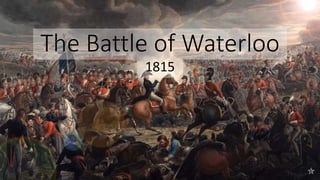
The Battle of Waterloo.pptx
- 1. The Battle of Waterloo 1815
- 2. Historical Context • For more than a decade one man had dominated Europe: Napoleon Bonaparte, Emperor of the French. • By his military genius he had managed to conquer an empire which spanned the continent. • After the failed invasion of Russia, his enemies attacked him and the Quadruple alliance of Austria, Great Britain, Prussia, Sweden, and Russia defeated Napoleon at the Battle of the Nations. • He was exiled to Alba, an island near the coast of Italy while the Bourbons were reinstalled in France.
- 3. • At Elba rumors reached Napoleon that the French people would welcome his return. • They were not happy being ruled by the same monarchy whose behavior had caused the French revolution. • The news of a dispute among his enemies at The Congress of Vienna also got to Napoleon.
- 4. • After spending just 10 months in exile Napoleon returned to France on 20th of March 1815. • The troops who were sent to arrest him rallied to his side instead and chants of Vive L'Empereur broke out. • On 20th March 1815 Napoleon entered Paris with the army and the French people in his support.
- 5. • Seeing all this, the coalition put their differences to the side and started the mobilization of their armies. • Napoleon knew he would have to act fast and boldly before the coordinated invasion from the coalition took place. • He wanted to be in a power of strength while negotiating so he could not be pinned down.
- 6. • In easy reach of Napoleon were the Prussian army led by Field Marshal Gebhard von Blucher numbered at 122,000 men • And the Anglo-Allied army led by the Duke of. Wellington numbered at 93,000 men.
- 7. Napoleon's army alone was a match was either one of them But if the armies got together, they would outnumber Napoleon heavily.
- 8. He planned on keeping them apart, and for this he crossed the River Sambre on 15th June attempting to create a wedge between the two opposing armies. .
- 9. • On the next day Napoleon won against the Prussians at Ligny inflicting 20,000 causalities while suffering half of these himself. • 72-year-old Blucher led a cavalry charge himself but had his horse killed under him, he somehow managed to escape. The Prussians had to retreat.
- 10. • On the same day, the French army fought Wellington’s army at Quatre Bras. • The Anglo-Allied force emerged victorious but due to the defeat of the Prussians they had to retreat because of the fear of being flanked. • Wellington fell back to the village of Waterloo some 8 miles from Brussels and fortified his defenses because the question of going into the offensive with his mixed army did not rise.
- 11. • Waterloo had a very good strategic position. • Wellington placed his army next to the ridge to protect his army from artillery fire. • There were three outposts front of the ridge. • The Chateau of Hougoumont • The farmhouse of La Haye Sainte • The farm of Papelotte
- 12. • Napoleon’s plan to counter this was simple. • He would launch a diversionary attack on the Hougoumont farm. • After this he would launch his main attack from the centre.
- 13. • The attack began at 11:30 am, after a huge artillery barrage by the French from which Wellington suffered some losses but due to his position and wetness of the ground, they proved negligible. • Napoleon launched his diversionary attack against the Hougoumont and after fierce fighting the chateau remained in British hands at the end of the day. • The French army was able to enter it, but they were quickly repelled by the guarding forces.
- 14. • The French army also attacked the center of Wellington’s army. • As they approached the ridge British cavalry stormed their infantry. • But they took the charge too far and were massacred and torn apart by the French cavalry.
- 15. • The arrival of the Prussians forced Napoleon to form a defensive line. • The Prussians took control of the village of Plancenoit. • Napoleon had to send his reserves to take back the village.
- 16. • The French cavalry charged the center where Wellington formed square and held their ground. • When it seemed that the Anglo-Allied forces were about to lose ground due to the French capturing La Haye Sainte and crushing Wellington’s army with heavy close-range artillery fire. • The Prussians captured the village of Plancenoit and Napoleon decided to recapture it first which gave Wellington the time to reorganize.
- 17. • In the last bid to win the battle Napoleon used his wild card, The Imperial Guards who were the most elite and feared forces in the entirety of Europe at that time. • Three thousand of these battle-hardened veterans attacked where Wellington was the strongest but eventually, they were defeated. • The defeat of the Imperial Guards sent a wave of panic among the French troops who retreated, and Napoleon just barely escaped.
- 18. Blucher and the Duke of Wellington met outside Napoleons headquarters and celebrated their win.
- 19. • Napoleon, now with no army to raise surrendered. • He was sent to the far away South Atlantic Island of St Helena where he spent the rest of his life. • The Napoleonic Era finally came to an end